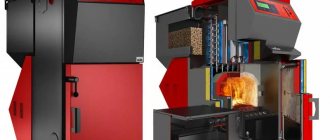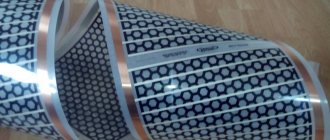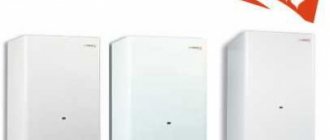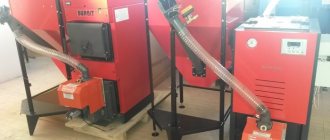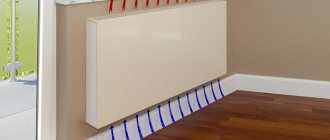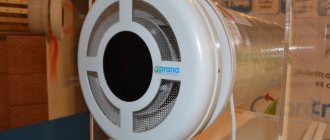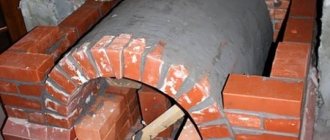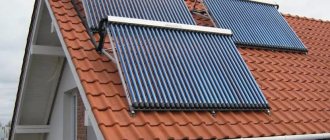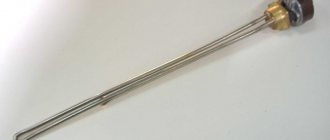Homeowners who use solid fuel stoves for heating know firsthand such a nuisance as the room cooling down after the wood in the stove burns out. This can happen at night or during a prolonged absence of the owners.
In these cases, a wood-electricity combination boiler for heating a private home will help maintain the temperature. Such heat sources are equipped with automation that monitors the system - if the stove goes out and the water in the boiler cools down, it sends a command to turn on the electric heating elements.
Externally, a combination boiler is practically no different from a standard one Source darizz.access.ly
Installation requirements
When installing a combi boiler, you must adhere to the following rules:
- Since the heat generator is a powerful electrical appliance, there should not be high humidity in the room where it is installed. The possibility of water getting into electrical contacts must also be excluded.
- Solid fuel equipment is usually quite heavy. Therefore, before installation, you should evaluate the ability of the floor to withstand such a load. If necessary, the boiler is installed on a concrete foundation. If the floor is strong enough, simply place a fireproof stand under the device, which extends 300 mm beyond its outline on each side.
- The floor surface in front of the boiler within a radius of 1.2 m from the center of the combustion door must be covered with fireproof material. Typically, a steel sheet of at least 1.5 mm thickness is laid on top of the asbestos underlayment.
- The distance between the boiler and the wall must be at least 1 m, and the walls must not be decorated with flammable materials (for example, wallpaper). If the walls are finished with fireproof plaster (for example, vermiculite) with a layer thickness of 25 mm or more, the minimum distance can be reduced to 0.8 m.
- The cross-sectional area of the chimney must be equal to or greater than the flue pipe of the boiler.
- Electric heaters with a power of up to 7 kW can be connected using a single-phase circuit, more powerful ones - using a 3-phase circuit. The device must be grounded and connected through an RCD with a leakage current of 30 mA.
Before purchasing a combination boiler, you need to make sure that the electrical network is designed for the power of its electric heaters.
We are talking not only about in-house wiring and circuit breakers, but also about distribution network equipment.
For example, a user of one of the forums reported that in order to connect a 15-kilowatt electric boiler, he had to pay for the replacement of a transformer at a substation. When connecting the boiler to the heating system, take into account the following points:
- It is impossible to quickly reduce the power of a solid fuel unit, unlike a gas unit, so it is necessary to provide for the possibility of emergency cooling of the overheated coolant and releasing excess pressure when it boils. Rapid cooling by supplying cold water is only possible in boilers with steel heat exchangers - cast iron ones can burst from a sudden temperature change. To relieve pressure, a safety valve is installed at the beginning of the “supply” line.
- If there is a flame in the firebox, do not allow a working medium with a temperature below 50 degrees to enter the heat exchanger. In this case, the steam contained in the flue gases (reaction water) will condense on its walls, which will immediately react with the oxides of various elements and turn into an acid cocktail. Under such conditions, the walls of the heat exchanger quickly collapse due to thermochemical corrosion. To prevent this from happening, a jumper with an automatically controlled 3-way valve is installed between the “supply” and “return”, through which the cooled coolant is diluted with the hot one.
The efficiency of a solid fuel boiler is maximum only if the device operates at or close to its rated power.
In order not to run the boiler at half speed in relatively warm weather, it is strongly recommended to include a heat accumulator in the form of a container of water in the heating system.
Installation and rules for using the device
Since the device operates on several types of resources at once, you should be especially careful when using it. In addition, the installation of the boiler should be carried out as much as possible in accordance with the instructions in order to avoid further problems during use. The work should begin with planning the placement of the system. A separate room will be required, since combined heating with electric wood is best placed isolated from other elements of the housing. The boiler itself should be placed on a concrete pad; in addition, you will need to think through and install a chimney and ventilation system. If you don’t want to deal with the installation of a heating system, then it is better to turn to professionals who will not only quickly bring the matter to the final stage, but will also issue a guarantee for the work done. The principle of a combination boiler in a private house, details in the video:
Disadvantages of combined heating units
Against the backdrop of the undeniable advantages of universal installations, it is worth noting that they also have a number of disadvantages. Thus, in comparison with traditional heating systems, combination boilers have a higher price. But the purchase costs are more than recouped in the first years due to the interchange of one type of fuel with another.
Universal boilers are made of cast iron, known for its anti-corrosion properties, which are very valuable due to the constant formation of condensate in the system. But due to this, cast iron installations have a rather high weight and therefore are presented only in a floor-standing version.
The cost of purchasing a boiler will soon pay off
For installation of the device, in order to create conditions for the uninterrupted functioning of the system, and for the storage of solid fuel, it is necessary to allocate a separate room.
A significant disadvantage of this type of units is the low power of their electrical part. This limits the number of built-in electric heaters. After all, the total power of electric heaters should not exceed the power of the wood burning chamber, the range of which varies between 6-25 kW.
By choosing a combination boiler, you can “kill two birds with one stone”, reinsuring yourself and the inhabitants of the house for the future, having two energy sources in reserve. A combination boiler can act as both the main heat source and serve as a backup heating system.
How to achieve joint operation of electric and solid fuel units
If you are faced with a choice of which individual heating option to give preference to - a solid fuel boiler, an autonomous electric unit or a combination of these two devices, the latter option has advantages. To install the circuit, you will need a connection diagram for both units, similar to a gas-solid fuel heating system. Properly done equipment piping is a guarantee of the efficiency and safety of operation of this equipment.
The proposed video describes in detail how and in what way to connect solid fuel heating devices together with electric heating elements
What you need to pay attention to during installation:
- both devices must have a reasonable power ratio, the coal or wood heating device is the main source of heat, so its power must be twice the power of the electric boiler;
- both units are connected in parallel, which makes the operation of one independent from the other;
- the solid fuel unit is the main one and is connected to the large circuit, while the electric boiler is responsible for the temperature in the small circuit;
- the main heating unit is equipped with a three-way valve;
- to save energy resources and ensure heating safety, installation of a heat accumulator is mandatory;
- each heating device is set to a certain heating temperature - for solid fuel equipment the operating temperature should be 60-70 0C, while on an electric unit the temperature value is set to 40-50 0C, since due to the presence of a heat accumulator, the water for heating will cool more slowly, and the electric boiler will start with a time delay.
Features of gas-fired boilers for home
First of all, it is worth noting that in most cases they take the gas main as the main fuel, and switch to wood heating in case of shutdown for periods of maintenance or accidents. Of course, for a completely universal approach, it is worth installing a combined wood-gas-electricity device, but not everyone can be satisfied with the cost of electricity.
In general, combination boilers can be fired with different solid fuels, with almost no changes in its design. So, firewood, coal, briquettes, pellets - everything is at the same level in terms of prevalence, the choice depends on the price of various types in a particular region. This is why gas-wood boilers are popular; solid fuel is easy to replace with an analogue.
Rice. 2 Appearance of a gas-wood boiler
Secondly, it is important to consider that solid fuel heating boilers are made of steel and cast iron, which makes them resistant to constant high temperatures during the heating season. This is especially important if coal is used as fuel, which gives a noticeably higher temperature in the firebox
But this also adds hassle. The heavy weight of the equipment in some cases requires reinforcement of the flooring in the room in the house allocated for its installation. Cast iron gas-wood heating boilers require this without fail. Gas-fired modifications made of light metals can be mounted on a regular floor, in the place previously occupied by a wood-burning or coal-fired stove. Wood-gas-electricity appliances are usually light in weight.
There are two more types of combined models: single-circuit (they only work to heat the heating system) and double-circuit (the second circuit heats water for the water supply system in the house). Thus, the gas-wood device can be used as a boiler even in the warm season. The same applies to the wood-gas-electricity device.
It is also worth noting this feature. In addition to the removal of smoke through a chimney, when burning solid fuels, there are also solid combustion products that settle in the pan and require periodic disposal.
The most interesting boilers for heating are universal gas-wood-pellet boilers, which have the ability to operate autonomously without human intervention for a long time. Such a heater, instead of firewood or gas, can work with special granules. This combined option eliminates the need to stock up on firewood, because pellets are usually always available for sale. Alternatively, a combi boiler is also convenient.
Extra options
Important details to know:
- boilers must be used for their intended purpose, that is, coal cannot be used in devices intended for burning wood;
- It is better to install a damper near the chimney, although it is used extremely rarely in combination boilers;
- the combustion regulator is not the most significant part, as well as complex automation systems, since the task of adjustment can easily be handled independently using the blower door;
- A water temperature sensor with a thermometer connected to the body must be present, otherwise you may miss the moment of boiling and cause an accident.
Combination boilers wood electricity
The most popular among consumers are wood-electric combination heating boilers. This popularity is explained by the relatively low cost compared to TGE models and the availability of energy. Electricity, unlike gas, is available even in the most remote places, and it’s not difficult to stock up on firewood.
Advantages
In such boilers, solid fuel acts as the main fuel, and electricity serves only to maintain a comfortable temperature in the house. Modern models can make the transition automatically based on time or upon reaching a certain temperature in the room. It is especially convenient to use electricity at night, when the owner cannot personally control the combustion process of wood during sleep.
The most important advantage of the unit is the use of a two-tariff electricity meter at night. The ideal economical system is heating at night, and during the day, only maintaining the temperature with wood and using it in case of problems with the main energy source.
How to choose a wood-electric boiler
A wood-electric combi boiler can be single- or double-circuit. In the first case, the unit only heats the room, and in the second, it also heats water for domestic needs.
If you decide to opt for this type of combined boilers, then when purchasing a heat generator of this type you should pay attention to the following nuances:
- firebox volume;
- possibility of silent operation;
- heat generator power;
- unit weight;
- grate material;
- heat exchanger material.
The last two points are worth clarifying in more detail, since the efficiency and service life of the combined boiler depend on them. Grate bars can be made of cast iron or ceramics. Cast iron is preferable when firewood is used as solid fuel; they are more heat resistant. Ceramic grate bars are more suitable when you plan to use bulk fuel - pellets, straw, sawdust.
Heat exchanger material
The heat exchanger can be made of carbon steel, cast iron or stainless steel. The first option tolerates temperature changes well, but is susceptible to corrosion. However, this drawback can be eliminated if non-freezing liquid, rather than water, is used as a coolant.
Coolants made of stainless steel and cast iron are not subject to corrosion, but cast iron does not tolerate sudden temperature changes and mechanical damage, and a heat exchanger made of stainless steel has half the service life.
Automation of home heating with wood
So, during the operation of the boiler, one bookmark burns for 3-4 hours. This is acceptable when it is possible to be near the boiler.
And it is completely unacceptable when there is a need to leave for 8-10 hours, for example, to go to work or, simply, to go to bed.
If nothing is done, then after 4 hours the coolant will begin to cool and the temperature in the interior of the house will begin to drop.
In this case, the electric heating element is automatically switched on based on the coolant temperature.
That is, after laying firewood in the evening, you can safely go to bed. After about 4-5 hours, when the temperature of the coolant begins to decrease, an electric heating element will be connected to the heating, which will maintain the desired temperature.
Of course, a 3 kW heating element will not be able to heat a house with an area of 150 or 200 square meters. But, nevertheless, it will not allow the coolant to cool down too much.
And in the morning you can wake up in a relatively comfortable temperature and make the first addition of fuel to a warm boiler.
Advantages and disadvantages of combi boilers
The primary criterion for choosing a heat source and type of fuel is, as a rule, economics. The heating installation must provide the required amount of heat for the home, while energy costs for it must be minimal
Such a criterion as convenience and comfort in operation, which a combination boiler can provide, is usually not taken into account
Many specialists involved in the installation and wiring of heating units confirm the following fact: a homeowner who has a household solid fuel boiler, after some time turns to the specialist with a request to install another electric or gas heater. Every person wants to have acceptable comfort and convenience in his home; a gas-wood combination boiler for heating a private house can provide them.
The economic component is also taken into account in the operation of hybrid installations. By burning wood as a more accessible type of fuel, you save money and switch to natural gas only when necessary. After all, if the coolant in the system cools down, you will still have to spend twice as much wood to heat it to the required temperature. The gas burner will automatically maintain the required temperature until you load the next portion of firewood.
Multi-fuel boiler
If electric or gas heating boilers are constantly used to heat your home, you may find yourself in a situation where you do not have enough limits allocated for electricity or main gas. To heat your home, you have to purchase an additional solid fuel unit, avoiding increased payments for energy used above the limit. Perhaps, being in limited conditions of their supply, you should rely on a gas-wood combination boiler for heating a private house.
The same conclusion can be drawn if you do not have the opportunity to purchase or store wood in the required quantity for the entire heating period. Combination solid fuel heating boilers with one chamber, which can be converted for different types of fuel, may be appropriate here. Initially, heat your house with wood, and when it runs out, install a burner and heat it with natural gas for the rest of the winter.
Like any other equipment, gas-wood combination boilers have their disadvantages:
- The weight and dimensions of the units are quite large.
- The high cost of the equipment is justified by its functionality, because you get 2 boilers in one.
- The burning time of the firebox with wood is short, since part of the installation volume is allocated for the second gas combustion chamber.
- The efficiency of hybrid boilers is slightly lower than that of their counterparts made separately for each type of fuel.
- Due to their design features, universal heating boilers are difficult to install, configure and maintain. This presupposes a permanent connection to one or another service department.
Using long-burning TT boilers
Not every homeowner has the technical ability to connect powerful electrical equipment, which includes combined and purely electric boilers. The reason is the limitation of the allocated power limit for a private house. The size of the limit depends on the capacity of local power supply networks, which the owner of a country cottage cannot increase.
In the absence of natural gas on the site or with the high cost of connecting to the main line, there is only one real solution - buy a long-burning wood and coal boiler or make it yourself. The operating time from 1 load for a conventional TT boiler is 3-6 hours, which forces the owner to work near it as a stoker. A comfortable interval between fuel additions is at least 8 hours, and not every heater provides that much.
The latest pyrolysis boiler with an increased firebox volume ATMOS D30
The trouble is that any seedy manufacturer calls their products long-burning boilers in order to sell them to an ignorant user. You can recognize the correct unit among other heat generators by the following features:
- with the same power, a boiler with a large power reserve is equipped with a firebox of increased volume (from 100 l) and differs in size;
- the passport indicates a burning duration of 8 hours (on wood);
- For convenience, the unit is equipped with an additional loading door.
Detailed information about heat generators of this type and recommendations for their selection are published in a separate topic.
Rating of combined boilers
A large number of different models sometimes causes difficulty in choosing even for specialists, not to mention ordinary buyers, so we publish the top 5 models. For clarity, let's summarize the data in a table.
Table 1. The best models of 2018-2019
| Model | Fuel types | Description | power, kWt | Efficiency,% | Weight, kg |
| ZOTA MIX-20 | Coal, firewood, gas, diesel fuel electricity | A model from a Russian manufacturer that consumes basic types of fuel without problems. Withstands short-term pressure increases up to 4 atm (working 3 atm). The material of the heating elements is a seamless stainless steel tube. Their operation is controlled by an external control panel. The device is also equipped with a draft regulator and a thermomanometer, which increases the efficiency of the combustion process. To protect against heat loss, the water jacket is insulated. Wear resistance of the outer casing is achieved thanks to powder paint coating. | 3-9 | 80 | 140 |
| KARAKAN 16TPEV 3 | Firewood, gas, electricity | The dual-circuit model of the Russian manufacturer is especially popular among rural residents, because It is equipped with a wide hob on which you can cook food for yourself and your livestock. The unit can easily heat an area of up to 160 sq.m., this applies not only to residential, but also to industrial premises, incl. greenhouse or garage. The depth of the steel firebox is 0.56 m. The “water jacket” prevents the metal from overheating or burning out, which makes the device’s service life long. | 9 | 75 | 120 |
| Teplodar Cupper PRO 22 | Firewood, coal, gas, pellets | The domestic model can easily heat rooms up to 220 sq.m. When using firewood or coal, the unit acquires the features of a long-burning boiler, since on one tab the operating period is 8 and 10 hours, respectively. Another plus is the spacious firebox, which can accommodate firewood up to 600 mm long. | 6 | 80 | 115 |
| Kiturami KRM 30R | Firewood, briquettes, coal, diesel. | The double-circuit boiler from South Korea is equipped with several combustion chambers and electronic control. Capable of heating a room up to 350 sq.m. The heat exchangers are made of alloy steel, so you should not increase the pressure too much. | 35 | 85-92 | 170 |
| Protherm Bison 40 NL | Gas, diesel, fuel oil | The double-circuit model from Slovakia is capable of heating areas up to 400 sq.m. The control is carried out using a microprocessor, and the electronic display clearly shows the operating parameters of the boiler at any given time. | 38 | 89 | 148 |
Appearance of the Protherm Bizon 40 NL boiler
The choice is obvious - maximum comfort in fuel combination
The benefits of using combined options make them extremely popular in modern conditions. Efficient and economical automated solid fuel boilers with electric heating elements are increasingly appearing in homes far from the benefits of civilization.
In such devices you can burn not only wood. Coal, capable of burning for up to 70 hours in a row, provides heat no worse than wood. In addition, today in many cities the production of fuel pellets has been established, which provide more energy than simple firewood.
Even small-sized objects can be equipped with autonomous heating devices - boilers for wood-burning saunas cope perfectly with the fairly high requirements for such premises in terms of temperature conditions. And supplemented with electrical elements, they will be able to maintain an optimal atmosphere in them even during the downtime of the sauna between visits.
Each homeowner will be able to see for himself by testing modern heating boilers in his home - this is the most optimal option for combining heat sources for a private home, allowing for the efficient and economical use of heating equipment.
How to choose an electric wood-burning boiler
Before purchasing a boiler of this type, you should decide on some of its parameters:
1. Boiler power
Power selection is carried out in the same way as for any other boiler. It is best to order a thermal calculation and heating system design from a specialized company. If this is not possible, you can use the average statistical value of the specific power of heating systems, which is 130 W / per square meter. m for houses with an area of 100 - 150 sq. m and 85 W/sq. m for houses with an area of 400 - 500 sq. m. By multiplying the specific power by the heated area, you can determine the required boiler power. So, for example, to heat a house with an area of 125 square meters. m you will need a unit with a power of 125x130 = 16,250 W or 16.25 kW.
Do not forget that an electric wood-burning boiler places special demands on home wiring. Make sure that it will be able to “pull” the unit you like.
2. Weight
Devices of this type, especially powerful ones, are quite massive. Before purchasing a boiler, evaluate the load-bearing capacity of the floor and the possibility of strengthening its structure in the room where the boiler room will be located.
3. Material and design of the grate
If wood fuel predominates, you should choose a boiler with a cast iron grate. If you plan to use bulk fuel frequently, choose a model with a honeycomb grille, which is made of ceramic and steel.
4. Availability of a second heat exchanger
Today, a combined wood-electricity boiler with the ability to connect to a hot water circuit is a fairly popular product, but it is not suitable for everyone
The fact is that at the moment of using hot water, all the attention of the boiler switches to it. In this case, the heated coolant stops flowing into the heating system, since it is it that is used to heat water in the second heat exchanger
If for some needs you have to open the hot water tap for a long time, installing a double-circuit boiler does not make sense. In this case, you will simply be left without heating.
5. Heat exchanger material
Cast iron heat exchangers are considered the most preferred. They are not subject to corrosion, due to their high heat capacity they can smooth out short-term drops in boiler power and do not have weak points in the form of welding seams, since they are prefabricated. The steel heat exchanger is a welded structure, it is less durable and is susceptible to rust, but, unlike cast iron, it does not collapse under sudden temperature changes.
Features of the use of multi-fuel systems
Any option has advantages and disadvantages: an electric wood-burning boiler is no exception.
- For example, compact heating devices cannot be fully dual-mode. To heat a medium-sized home, a solid fuel boiler with a capacity of 20 kW is required. To fully replace the energy source, a heating element of similar power is required. In fact, multi-boilers use heaters with a power of no more than 6 kW. We are talking about systems that are affordable. Of course, the efficiency of an electric heater is higher than that of solid fuel, but still, 5–6 kW is not able to warm up an entire house. Therefore, the system considered is only auxiliary. If you want to use electricity to its fullest, you should install a double-circuit storage boiler.
In this case, you can accumulate heat using an electric heating element, using it during low tariff periods (for example, at night). Then organize heating with solid fuel, with heat backup from the boiler. - Another problem is condensation on the inside of the firebox. An inoperative solid fuel combustion chamber, together with a hot coolant, provokes droplet formation. This leads to unwanted corrosion. To prevent this phenomenon, install a small circuit with a three-way valve.
When kindling, condensation will not occur, and dampness will not interfere. - When the boiler is left unattended and the wood burns out, cold air moves in the combustion chamber. The jacket with the coolant, which is heated by the heating element, is forcibly cooled, reducing efficiency. This cannot be dealt with, since the operation of the automation that closes the chimney damper can lead to carbon monoxide entering the room (such devices exist, but they are quite expensive). Therefore, you have to put up with this problem.
Combination heating boiler
To make your home comfortable and cozy in the winter, you need to think about a heating system that will work under any conditions.
A combination heating boiler, which is capable of operating on two or more types of fuel, is becoming increasingly popular.
If one of them is missing, it can automatically switch to the other and vice versa.
Combination boilers have the following advantages:
- Protection against supply interruptions of one type of fuel;
- Savings due to the flexibility of choosing heating modes;
- High efficiency rate (over 90%);
- It is possible to automate the heating process;
- Modern models allow you to connect more than one heating circuit;
- Combination boilers can have different configurations and structures; some models can operate on four types of fuel at once.
However, such universal devices are too expensive, so the most popular among consumers is equipment that runs on two types of fuel:
- Firewood-electricity;
- Firewood-gas;
- Gas-electricity;
- Firewood is electricity.
The most popular among potential buyers are combined wood-electric heating boilers.
A fairly practical and well-thought-out design allows you to install such equipment in a small storage room of a private residential or country house.
These models have only one significant difference from traditional ones: an additional heating element is installed inside the heat exchanger tank.
Most models are equipped with automation, which facilitates the operation of the equipment and performs a number of operations:
- Changes boiler operating modes;
- Regulates power;
- Switches between the fuels used.
Modern combined boilers for home heating, which run on wood and electricity, have a simple and complex design at the same time.
The firebox for solid fuel is usually located at the bottom.
A heat exchanger is installed on top, through which the coolant is transported in the system. When it comes inside, it receives heat transferred from the firebox.
A heating element – heating element – is installed inside the heat exchanger. When you switch the heat source, it begins to heat up and maintain the required temperature automatically.
Combined double-circuit heating boilers have become widespread, allowing you to connect simultaneously, for example, a home heating system and a heated floor; it can also be used as a backup source of warm water in the pipeline.
Advantages of the model
The advantages of combined heating in such heating systems are obvious. The model completely protects its owner from problems with electricity - you can always use gas or wood. In the absence of gas or wood fuel, the boiler can operate on electricity.
Construction of electric-wood boilers
A combi boiler has the following advantages:
- Versatility - heating is possible without resources;
- The boiler can quickly switch between operating modes;
- Boilers are able to maintain the required temperature at any time of the year;
- Easy to use and install;
- Reliability and durability of heating equipment;
- The ability to adjust the temperature in real time even when gas or wood is used;
Thus, combined boilers are qualitatively different from their closest relatives - heating devices that use only a strictly fixed resource, in particular gas. Design features
Components of a combi boiler
When switching to electricity, the heating of the house is carried out using heating elements. Practice has shown that with low-power operation, a combination boiler is capable of maintaining the minimum temperature in the house using electricity for several days.
c4407dd4b174d081ddb5620b6aca3d77.jpe 0b48952ce157a65ab42578d048ad28a8.jpe
Universal water heaters
Today, many consumers prefer to use powerful multifunctional equipment for heating the room, so they install combined heating boilers in their homes. Such devices make it possible to use gas and electricity (or other combinations) as energy carriers.
These are technologically advanced units that have the ability to switch to another type of fuel with minimal modifications. Some models combine solid fuel components, while others combine solid fuel with liquid or gaseous fuel.
Internal organization
Combined devices for heating a private home have become especially popular due to their versatility, thanks to which any type of fuel can be used. This effect is due to the special design of the device:
- two chambers for different types of fuel (solid, gas, electricity);
- integrated heating element;
- several outputs for different heating circuits;
- inflatable burner.
Additional outlets for connecting the heating system make it possible to heat several rooms at the same time, and they also reduce the main length of the radiator pipes.
Advantages of the device
Universal models have the following advantages:
- operate simultaneously on different fuels;
- reliable;
- operate autonomously;
- can serve as a backup heating option;
- comfortable to use.
Autonomy
Experts note that combination boilers provide complete autonomy. So, you can use main and bottled gas for heating until the system is connected to the central gas supply.
The universal design will keep your home warm if the electricity goes out. Solid fuel units that have structural elements for switching to gas or liquid fuel reduce the complexity of their maintenance process.
If you run out of liquid fuel, you can use a combination boiler to heat your house with wood. If due to bad weather it is not possible to prepare firewood, then using built-in tubular electric heaters you can heat the cottage using electricity. This will prevent the system from defrosting and prevent the inhabitants of the house from freezing.
Choosing the type of heating in a private household
Since installation restrictions in an individual house are minimized (you can generally build a separate boiler room next to the living space), there remains a relatively free choice of energy source.
What can be used for heating in the private sector?
- First of all, solid fuel. This can be coal, firewood, or fuel briquettes (essentially the same firewood). We will leave such exotic products as cow dung for areas where it is “found” in abundance.
- Gas in our country is quite a profitable option. Unless, of course, it exists in a specific locality.
- Electricity is valuable because it is available almost everywhere. With the possible exception of territory remote from civilization (there is no gas there).
When choosing fuel for a boiler, the first thing to consider is the cost per unit of heated area for a specific region. If logging is developed around you, the choice is made in favor of firewood.
If there is a coal mine nearby, firewood is needed only for kindling. Gas is almost always chosen immediately after connecting the house to blue fuel. Today there is practically no alternative (in terms of heat cost). Of course, we are talking about central gas supply; liquefied fuel in cylinders is unprofitable for heating.
Electricity is available almost everywhere (you just need to worry about the technical conditions in advance to provide the necessary power).
So, let’s assume that the technical capabilities of supplying any fuel are present. We will make an approximate calculation of the monthly heating costs of a cottage with an area of 200 m².
Important: Energy prices may differ for different regions, so the figures are approximate. The table below only shows the relative dependence of the cost of heat on the material.
Let's say you analyzed all possible costs, including delivery costs, and made a decision in favor of one type of fuel or another. We bought a boiler, integrated it into the heating system of your home, and entered into an agreement for the supply of fuel.
A year passes, and the forest in which firewood was collected was recognized as a specially protected natural area. Firewood must be transported 100–200 km.
An accident occurred at a nearby coal mine and it was closed. Coal has become more expensive than firewood.
A nuclear power plant was built nearby; the cost of electricity for the surrounding villages became so favorable that it was even more expensive to heat with natural gas.
How to protect yourself from such economic risks?
Features of different combinations
When choosing equipment of this type, you should focus on the energy resources available to you.
Solid fuel and electric heating element
A combined wood-electricity boiler (labeled TE) operates on two types of fuel and in its design differs significantly from universal units of a similar purpose. It consists of one fuel chamber in which wood is burned. Above the firebox there is a water tank into which the chimney is integrated.
If, to increase the efficiency of the water heater, a thermal chamber is mounted above the tank, then the chimney is adjacent directly to it. In this case, combustion products heat the water by circulating through pipes located inside the tank.
At the moment of transition from solid fuel to electricity, heaters (heating elements) installed in the heat exchanger tank come into operation. The maximum power consumption can be limited arbitrarily. Full control of this type of heating device is carried out using an automatic system.
Solid fuel and gas
A combination boiler for a private home (labeled TG), which alternately runs on solid fuel and gas, comes in two types: with one and two fireboxes. In a double-circuit boiler, the lower firebox is intended for a gas burner, and the upper one, equipped with a chimney, is for firewood.
This option is convenient because with any operating firebox, the entire structure warms up evenly. The control process for universal mixed-type boilers is performed in manual or automatic mode.
Gas and electricity
Combined heating boilers, which are designed to operate on gas or from the electric network, are most in demand in areas where the laying of a gas pipeline is planned in the near future. Thus, you can switch from one heating mode to another at the first opportunity with absolutely no problems.
Technical design features
Combination heating boilers use four types of fuel:
- gas;
- electricity;
- solid energy carriers (coal, firewood);
- liquid fuel (fuel oil, used motor oils).
Contour
There are the following types of combined heating units: single-circuit and double-circuit.
The first ones have limited functionality - they provide heating for the house, while the double-circuit ones also heat the water.
Since universal boilers are made of cast iron, they are quite massive and therefore have only a floor-mounted design. Cast iron has high corrosion resistance, which is important if liquid fuel is burned.
Tank
Certain models include a hot water tank. Some dual-circuit devices are not equipped with a container; then they are connected to a reservoir, which is installed near the unit.
Almost all heating units are controlled automatically. This is very convenient because you can arbitrarily select a program, adjust parameters and monitor the operation of the equipment.
To ensure warm water supply, combined double-circuit boilers include a heat exchange unit, which is characterized by increased productivity - up to 250 liters of water every hour! It is possible to install a boiler. A double-circuit water heater has several outlets. This will allow you to make warm floors at home and produce heating using radiators.
